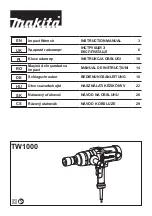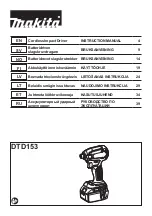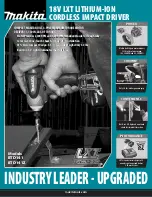
TROUBLESHOOTING
SERVICE AND REPAIRS
All quality tools will eventually require servicing or replacement of parts due to wear
from normal use. These operations should ONLY be performed by a licensed profes-
sional technician. Never try to repair the tool by yourself.
Disconnect tool from air supply before performing any
service procedure.
WARNING
SYMPTOM
PROBLEM
SOLUTION
Tool runs slowly or
will not operate
1. Grit or gum in tool.
2. No oil in tool.
3. Low air pressure.
4. Air hose leaks.
5. Pressure drops.
6. Worn rotor blade.
7. Moisture blowing out
of tool exhaust.
1. Flush the tool with air-tool oil or
gum solvent.
2. Lubricate the tool according to the
lubrication instructions in this manual.
3. Adjust the regulator on the tool
to maximum setting. Adjust the
compressor regulator to tool
maximum of 90 PSI.
4. Tighten and seal hose fittings if
leaks are found. Use sealing tape.
5. Be sure the hose is the proper
size. Long hose or tools using large
volumes of air may require a hose with
an I.D. of 1/2 in. or larger depending
on the total length of the hoses. Do
not use a multiple number of hoses
connected together with quick-
connect fittings. This causes additional
pressure drops and reduces the tool
power. Directly connect the hoses
together.
6. Replace rotor blade.
7. Water in tank: drain tank. (See air
compressor manual). Oil tool and run
until no water is evident. Oil tool again
and run 1-2 seconds.
Abnormal vibration
and/or excessive
heat develops in
the tool.
Improper lubrication.
Follow proper lubrication procedures
in this manual.
FOR YOUR SAFETY
PLEASE READ THESE INSTRUCTIONS CAREFULLY
AND RETAIN THEM FOR FUTURE USE.































